 |
Florida Marine Surveyors 954 952-8719 Ian Morris SAMS® AMS® Senior Surveyor Fort Lauderdale, Florida |
OUTBOARD PROPELLERS -
|
It is important to you, as a boater, to understand the basics of propellers. This will enable you to determine the propeller that is best suited for your application. The following is only a guide; to save time, ask your marine dealer or boat manufacturer for advice on selecting a propeller. The propeller on your outboard motor is the means by which the horsepower, developed by the engine, is converted into thrust to propel your boat. As such, its care and selection is very important to insure continuous service and satisfactory performance. Several propeller options are available to you, if you want to change your performance for better top end speed or to increase load carrying performance. Materials Composite and plastic propellers are generally used for emergency situations. Aluminum propellers, being the most common, have reasonable durability for most applications. Stainless steel propellers are stronger than most all other propeller materials. Some advantages are longer life and high hydrodynamic efficiency derived from stiffer blades. | |||||||||||||||||||||
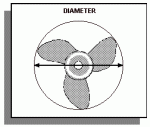 |
Diameter Diameter is simply the width of the circle described by the rotating blades. |
||||||||||||||||||||
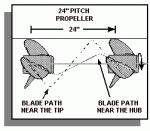 |
Pitch Pitch is the angle of the blades expressed in inches of theoretical travel in one revolution of the propeller. This propeller has a pitch that will theoretically result in 24in. of forward travel in one revolution. In use, the propeller experiences slippage so that its actual travel per revolution is less than the stated pitch. |
||||||||||||||||||||
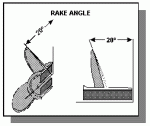 |
Rake Rake is the measurement of the angle of the tilt of the blade's tip toward or away from the gear case. The angle is measured on a line extending from the center of the hub through the center of one blade. |
||||||||||||||||||||
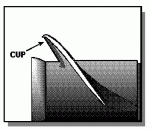 |
Propeller Cup Cup is the added curved lip on the trailing edge or blade tip. This added curvature will increase pitch when added to the trailing edge and increase rake when added to the tip. Cupping a propeller will cause a decrease in RPM. The actual amount of RPM decrease is dependent on where, how much, and the quality of the cupping. Cupping also tends to decrease ventilation and allows higher trim angles and transom settings. |
||||||||||||||||||||
|
Propeller Hubs Most propellers have a splined bushing in the hub that attaches the propeller to the propeller shaft. The bushing is mounted to the propeller with flexible rubber. This rubber acts like a shock absorber. If the propeller strikes something hard, the rubber flexes and helps protect the gear case components from damage. Identification There are several specifications that are used to define a finished OMC propeller. Besides the part number, a propeller is normally identified by two numbers, such as 13 x 9, followed by a material identification, aluminum or stainless steel. In the number sequence 13 x 9, the first number is the diameter, and the second number designates the propeller pitch. |
|||||||||||||||||||||
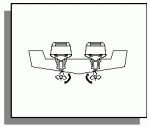 |
Counter-Rotation Steering can be a real chore with a dual engine power setup. When the props turn in the same direction, the boat tends to list and steer off course. Keeping an even keel and true course requires constant attention, especially in choppy water and high winds. Much of that problem can be solved by having two props turn in opposite directions. In other words, counter-rotation. The major advantage of counter-rotation is its ability to enhance performance by reducing steering effort in all RPM ranges. |
||||||||||||||||||||
| Most single engine boat setups normally operate in forward motion using clockwise rotation of the engine and gear case. Although counterclockwise rotation setups have been used since the creation of the outboard engine, the use of counter- rotation has become more prevalent in the last decade. This increase is largely due to the manufacturing increase of larger twin engine recreational boats and performance boats. To better understand how counter-rotation enhances performance, you must first understand what happens under normal conditions using clockwise rotation propellers. Clockwise rotation propellers, when turned in the same direction, will tend to list or walk to the right side of the direction they are moving forward in. |
|||||||||||||||||||||
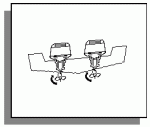 |
This illustration shows two effects of clockwise (Right Hand) propeller rotation. The listing of the propeller to the right, pulling the gear case in the same direction, and the effect of propeller torque, causing the boat to roll over to the port side. | ||||||||||||||||||||
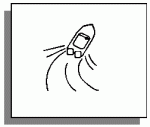 |
This illustration shows how clockwise (Right Hand) propeller torque forces a boat into a right hand turn. | ||||||||||||||||||||
|
Left-handed or counterclockwise rotation is usually accomplished by using a special gear case configuration that rotates opposite of engine rotation under normal operation. Counter-rotation is mechanically achieved by driving the gear clutched to the prop shaft in counterclockwise rotation when shifted into forward gear. A counter-rotation gear case is completely different than a standard gear case, as it is comprised of special parts that provide strength and durability to accomplish this reversed rotation. Ventilation and Cavitation Ventilation occurs when surface air or exhaust gases are drawn into the propeller blades. The load on the propeller is reduced by the mixing of air or exhaust into the water steam causing over revving. Anti-ventilation Plate: Large plate cast into gear case housing directly above propeller. Helps reduce surface air from being pulled into blades. Cavitation: The aeration (bubbling) and boiling effect of water caused by creation of a low pressure area. Generally caused by a solid shape (propeller blade) passing through the water, in such a position and speed, that a low pressure area is formed due to the inability to move through the water in nonresistant manner. An example is, a propeller blade that has a rough edge would not cut efficiently through the water, thus creating a low pressure area. If the pressure drops below the vapor pressure, a cavitation bubble will form in that region. These bubbles will collapse when they reach the higher pressure region of the blade. This causes a rapid change in pressure and can result in physical erosion. You may notice burns (erosion) at some area on the face of the blade. Common rules of thumb: Ventilation can lead to excessive slippage. Cavitation can lead to ventilation and/or slipping. |
|||||||||||||||||||||
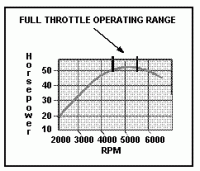 |
Operating Range The following chart illustrates a typical outboard motor horsepower curve. The curve represents data that is determined by running an engine on a dynamometer through the RPM range up to W.O.T. (Wide Open Throttle). This chart indicates a peak of 50 HP at 5000 RPM. 50 HP would be the engine's overall power rating. |
||||||||||||||||||||
| The recommended W.O.T. operating range is determined to permit operating latitudes without sacrificing engine durability or performance. The recommended W.O.T. operating range for this motor would probably be 4500-5500 RPM. The operating range is stated on the specification page of the Operator's Manual and is used when selecting a propeller. Maintenance Check your propeller often for nicks, rolled tips, or bent blades. Any distortion from normal will cause a loss in performance and can create vibrations harmful to the engine. A propeller with worn blades will allow the engine to accelerate beyond the recommended operating range which can result in damage to the engine. Keep the bottom of the boat clean. Tests prove that cleanliness plays an important part in boat performance. A fouled bottom, an accumulation of marine growth, moss and barnacles in sea water, and the accumulation of dirt, slime, lime, and other matter in fresh water, is the major cause of poor boat performance. Cleaning the boat's bottom frequently during your boating season will greatly improve boat performance. To show the dramatic effect cleanliness plays, a boat was left anchored in salt water for 40 days. The running tests were made with a 35 HP engine which was removed from the boat after each test. A three-man load was used. Speed:
To select the optimum propeller for the use of your boat and motor combination, keep the following guidelines in mind:
Have a selection of propellers to test with.
The correct size propeller will provide the best overall fuel economy and performance. "Thru-hub" signifies that exhaust gases pass and exit through the center hub of the propeller. "Over/Thru-hub" signifies that exhaust gases pass and exit through the center of the propeller hub and over the outside of the hub across the blades. Raker®: Is a "Thru-hub" 3-blade propeller with high blade rake to increase bow lift. [Rake is the measurement of the angle of the blade's tip toward or away from the gear case. The angle is measured on a line extending from the center of the hub through the center of one blade.] The Raker works well in surfacing conditions and where boat speed is already over 50 mph. The blades are highly polished and comprised of 400 series stainless steel. Bass Renegade®: Is an "Over/Thru-hub" 4-blade polished propeller that has a sharp leading edge and contoured cupping. The Bass Renegade is ideal to carry bass tournament style boats over rough water. In addition, it provides a good hole shot and excellent top end speed by keeping hooked up under the most grueling conditions. Under normal conditions, when switching from a Raker, an increase in pitch is recommended. The Bass Renegade comes with an accessory weed ring to help prevent propeller ventilation on acceleration on certain boats. Renegade® Offshore: Features a "Thru-hub" exhaust and 4-blade polished design. This propeller has moderate blade rake (less than Bass model) and is offered in lower pitches and left-handed rotation for heavier and twin engine boats. The Renegade Offshore is designed to propel twin engine offshore boats straight and true. It will allow you to maintain compass headings, stay hooked up in heavy seas, and reduce throttling down between swells. The Renegade Offshore also features great acceleration, top end speed, and fuel economy capabilities. When switching from a Raker or SST to this propeller, use a similar pitch size as RPM should be comparable. SST®: Features a "Thru-hub" exhaust, 3-blade painted stainless steel design. This low pitch propeller comes standard double cupped, and is also available triple cupped for pontoon applications. This versatile propeller is an ideal upgrade replacement for aluminum propellers that provides great performance for water skiing. In most applications, a direct pitch replacement is recommended when replacing. Tricks of the Trade The Quick Tips shown below have been taken from an average of setups that have actually been tried by boaters worldwide. As propping is not an exact science, there is no set guide to choosing a propeller. Under most circumstances, when switching propeller materials and/or number of blades, it is recommended to try a pitch size as close to the original as possible. Once an average loaded RPM has been established, it will be easier to determine a specific propeller pitch to meet the engine's recommended RPM range. Quick Tips Raker to Bass Renegade Conversions 26 Raker use 25 or 27 Renegade 24 Raker use 25 Renegade 22 Raker use 23 Renegade
Copyright © 2003, 2004 Boatfix, Inc.. All rights reserved. Boatfix.com specializes in marine engine parts and boating accessories; including risers, manifolds, alternators, starters, water pumps, bilge pumps, pistons, gaskets, lifejackets ( PFD ), hoses for MerCruiser, Crusader, OMC, Volvo, Sea Maxx, Evinrude, etc. (Gas and Diesel)- you name it. If it goes on a boat, it's in our catalog! | |||||||||||||||||||||
Go To Main Page
Copyright © 2003/2023 Morris Marine Surveyors Inc., info@floridamarinesurveyors.com
Installed September, 1, 2003, Last Revised July 3, 2023 - Hosted and maintained by MarineSurveyor.com